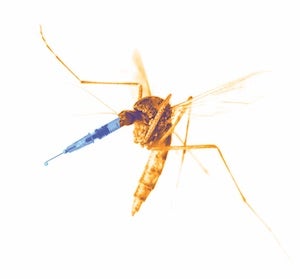LENS
Bioinspired Solutions
Taking lessons from creatures that sting, peck and morph

To develop a new method for pushing flexible implants into the soft, squishy tissue of the brain, Jeffrey Capadona, PhD, and researchers in his Case Western Reserve lab turned last year to an intriguing source for inspiration: the "guide arm" that mosquitoes use to steady their bite.
In past years, the lab's pioneering biomimicry experiments to improve the performance of neural implants have drawn ideas from how sea cucumbers change their skin from rigid to soft, the unique structure of squid beaks (hard at the tip, soft at the base) and the resilient skulls of woodpeckers.
As for the guide arm, it inspired researchers to create a small plastic disc that stabilizes the implant the same way a pool stick is stabilized by a player's non-dominant hand.
Studies have shown that brain implants—used to monitor electrical activity or diminish effects including tremors from diseases such as Parkinson's—often can degrade because the body perceives them as foreign invaders and goes on the attack.
But implants from Capadona's lab have more successfully tempered the body's natural immune response. Most recently, the team has improved the implants by coating them with materials to deliver antioxidants to the brain to discourage long-term tissue damage.
Capadona's ingenuity has won him national attention.
The associate professor of biomedical engineering—who also is a research health scientist at the Louis Stokes Cleveland VA Medical Center—was named one of the nation's 96 most promising young scientists in 2012 by President Barack Obama, receiving a Presidential Early Career Award for Scientists and Engineers, and recently earned the distinction of being named a research career scientist within the VA.
Capadona heads a group of 25 researchers that published 16 papers in the field in 2018 alone (60 since his 2010 arrival) and has been cited an average of 800 times annually during the last five years in publications by other scientists.
"The world is paying attention to what we do, so that is inspiring and motivating, too," Capadona said.
Now his team is planning research on a new and unexpected project: deploying the antioxidants to try to prevent tissue damage that opioids can cause in the brain.
"If you had told me even six months ago that our work would be going in this direction," he said, "I might not have believed it, but it's pretty exciting."





